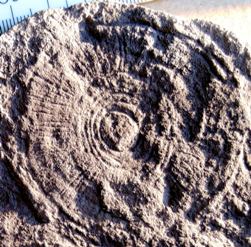Wreck of a medusoid?
 Joe McCall describes an important new finding of Ediacaran fossils in peninsular India
Joe McCall describes an important new finding of Ediacaran fossils in peninsular India
Geoscientist 22.09 October 2012
Caption: A ‘medusoid’ typical of the Ediacara fauna (not from India). Not all may be as it seems however. Tateana inflata (once known as 'Cyclomedusa' radiata) is now thought to be an attachment disk of unknown organism.
Chirananda De (Palaeontology Division, Geological Survey of India) has reported important new finds of Ediacara fossil assemblage associated with simple tubular trace fossils Planolites. The fossils come from purple biomat-bearing shales and siltsones of the Sonia Formation, Jodhpur Group, Marwar Supergroup, of Rajasthan, Western India1.
This discovery follows a similar one in the Vinhyans of Central India 2,3, and much earlier discoveries in the Krol Formation of the lesser Himalaya4. Thus there are now three widely separated Neoproterozoic fossil localities in peninsular India, consistent with the global distribution of these rare and unique soft-bodied fossils.
The fossils are all medusoids, similar to those found in NW Canada and S Wales 5, there being no branching Charnia-like forms, which dominate in Newfoundland 6. One Sonia medusoid is hexagonal, a novel peculiarity. Trace fossils Cruziana and Rusophycus are found higher up in the sequence, along with Diplicnites.
Trace fossils do occur in the Neoproterozoic 5; but there are also possible trilobite body impressions on the same bed, and in continuation with Cruziana higher up 6; so this succession appears to offer a more or less smooth transition into the Tommotian. If this possibility is upheld by future work, it would represent the very first palaeontological delineation of the Precambrian/Cambrian boundary in peninsular India.
References
- De, C and Prasad, S, 2012 Discovery of Vendian Ediacaran fossil assemblage from the Marwar Supergroup, Rajasthan Indian Journal of Geosciences, Vol 65, No 3, pp 241-242
- De, C 2003 Possible organisms similar to Ediacaran forms from the Bhander Gp, Vindhyan Supergroup, Late Neoproterozoic J of Asian Earth Sciences 21, 387-395
- De, C 2006 Ediacara fossil assemblage in the Upper Vindhyans of central India and its significance Ibid., 27, 660-683
- Shanker, R et al. 2004 Ediacaran biota from the Jarashi (Middle Krol) and Mahi (Lower Krol) Formations, Krol Group, Lesser Himalaya, India J Geological Soc of India, 63, 649-654
- McCall, G J H 2006 The Vendian (Ediacaran) in the geological record: Enigmas in geology’s prelude to the Cambrian explosion Earth Science Reviews 77, 1-229
- Prasad, S and De, C , 2012 Maiden palaeontological delineation of Pc-C boundary from Peninsular Proterozoic basin of Rajasthan Indian Journal of Geosciences, Vol 65, No 3, pp 243-244